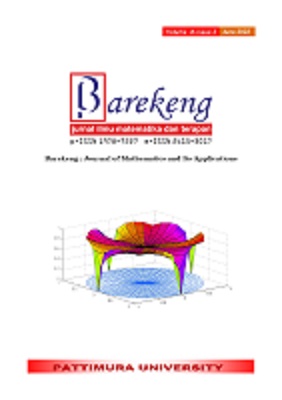DYNAMICS OF THE RUMOR SPREADING MODEL OF INDONESIA TWITTER CASE
Abstract
The study of the spreading of a rumor is significantly important to obtain scientific information and better strategies in reducing its negative impact. Twitter has become a medium for spreading rumors or hoaxes spatially and chronologically because it has a unique community structure. This study demonstrates the model of spreading rumors by considering credibility, correlation, and mass classification based on personality is discussed. The behavior of a model solution around equilibrium points is investigated with the Jacobian matrices. The stability also corresponds to a threshold number indicating the rumor fades away or continues to spread in the population. The analytical results are confirmed by actual data from Twitter in Indonesia with #SahkanRUUPKS. The simulation results show that the free rumor equilibrium point is stable and the threshold number is less than 1. Our study shows that the number of spreaders does not increase and the #SahkanRUUPKS rumor will vanish.
Downloads
References
E. A. Bender, An Introduction to Mathematical Modelling, New York: John Wiley And Sons. Inc, 1998.
N. Bellomo and L. Preziosi, Modelling Mathematical Methods and Scientific Computation, Torino, 1995.
S. H and A. Maulana, "Some Inquiries to Spontaneous Opinions: A case with Twitter in Indonesia," BFI Working Paper Series, pp. WP-10-2010, 2010.
Getdaytrends In Indonesia, [Online]. Available: http://getdaytrends.com/indonesia/trend/23SahkanRUUPKS/. [Accessed 23 Juni 2021].
Amnesty International, "www.amnesty.id," Amnesty Indonesia, 12 November 2020. [Online]. Available: https://www.amnesty.id/empat-urgensi-pengesahan-ruu-pks/ . [Accessed 24 Juni 2021].
F. L. Gaol, F. Hutagalung and C. F. Peng, Issues and Trends in Interdiscilinary Behaviour and Social Science, London, 2018.
D. D. J and K. D. G, "Epidemics and Rumours," Nature, p. 204:1118, 1964.
J. P. I, A. R. Putri and E. , "Analisis Perilaku Model SIR Tanpa dengan Vaksinasi," Barekeng: Jurnal Ilmu Matematika dan Terapan , p. 14:2, 2020.
C. Xuelong and N. Wang, "Rumor Spreading Model Considering Rumor Credibility, Correlation and Crowd Classification based on Personality," Scientific Report, p. 10:5887, 2020.
H. L and M. C, "Dynamical Analysis of Rumor Spreading Model with Impulse Vccination and Time Delay," Physca A, pp. 471:653-665, 2017.
X. L, G. Jiang, B. Song and Y. Song, "Rumor Spreading Model Considering Hesiteting Mechanism in Complex Social Networks," Phys.A, p. 437:295, 2015.
O. Diekmann and H. J. P, "The Construction of next generation matrice for comparmental epidemics models," Journal Of the royal society interface , pp. 7:873-885, 2009.
J. M. Harris, J. L. Hirst and M. J. Mossinghoff, Combinatorics and Graph Theory, New York: Springer Science+Business Media, 2008.
J. R. Brannan and W. E. Boyce, Differential Equations: An Introduction to Modern Methods and Application, New York: John Wiley and Son, Inc, 2011.
F. Breur, P. Driesche and J. , Mathematical Epidemiology, Berlin: Heidelberg, 2008.
Authors who publish with this Journal agree to the following terms:
- Author retain copyright and grant the journal right of first publication with the work simultaneously licensed under a creative commons attribution license that allow others to share the work within an acknowledgement of the work’s authorship and initial publication of this journal.
- Authors are able to enter into separate, additional contractual arrangement for the non-exclusive distribution of the journal’s published version of the work (e.g. acknowledgement of its initial publication in this journal).
- Authors are permitted and encouraged to post their work online (e.g. in institutional repositories or on their websites) prior to and during the submission process, as it can lead to productive exchanges, as well as earlier and greater citation of published works.






1.gif)



